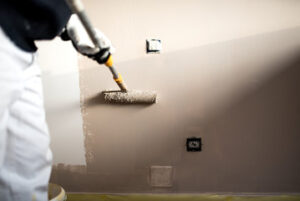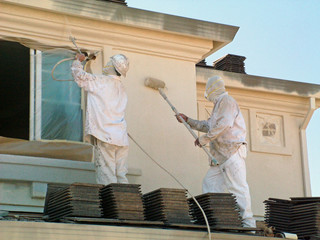Professional interior painters are adept at executing paint jobs that meet or exceed client expectations. They possess a comprehensive understanding of color theory and how different hues interact with each other.

They also know how to apply various painting techniques, including ragging, sponging and color washing, to create unique textures and effects. These details enable them to customize walls to reflect clients’ personalities and aesthetic preferences. Contact Painters Colorado Spring for professional help.
Professional interior painters have years of experience and honed skills that ensure high-quality outcomes. They understand that painting projects can be complicated, especially when working with different materials and wall surfaces. Their technical expertise eliminates unforeseen expenses associated with costly errors and rework. This ultimately provides a greater return on investment for their clients.
A quality painter should be licensed and insured. Licensing is a key component of professionalism, and it indicates that the professional has undergone a background check and has met local standards. Insurance protects you from any damages that may occur during the painting process and reassures you that your home is safe. Additionally, a reputable painting expert will have a clean reputation and solid communication skills.
In addition to their technical expertise, seasoned painters have an eye for detail and an understanding of design trends. They can help you choose the right color and finishes for your space that are aesthetically pleasing and will stand up to wear and tear.
When hiring a painting company, ask to see examples of their previous work. This will give you an idea of their style and skill level, and it will also let you see if their work matches your taste. Also, be sure to remove personal items from areas that will be painted or accessed by the painters and that there’s enough space for ladders and paint supplies.
Professionals are equipped with a variety of tools and equipment that allow them to achieve the desired results for any residential or commercial property. They know how to properly prepare surfaces, including sanding rough areas and patching holes, to create a smooth canvas for painting. In addition, they can apply proper sealant to surfaces that will prevent damage from moisture and wear-and-tear.
Skilled professionals will also provide you with an estimate before beginning the project. They will take into account factors such as the square footage of the area, the type and condition of the walls, and any repairs or other preparations that may be required. They will also address any special requests you may have, such as accent walls or specialty finishes.
Efficiency
Professional painting is a precise art form that involves numerous techniques. A competent interior painter is familiar with a range of tools and approaches that can be used for wall painting, such as ragging (creating texture using cloth), sponging, colorwashing (using multiple colors together) and stippling (using dots and dabs). In addition, they know how to properly seal surfaces, which helps prevent chipping and discoloration from humidity and wear-and-tear over time.
Interior painters also understand the importance of thorough preparation, which ensures that the final product is of high quality and can stand the test of time. They begin by cleaning surfaces and sanding rough or uneven areas to improve adhesion. They also make sure that they have sufficient room to move around and that any furniture or decorations are removed from the area to facilitate an unobstructed painting process.
Finally, they take time to mix their chosen paint thoroughly before applying it to the walls. This ensures an even, consistent color that is free of unsightly brush strokes. Moreover, they also take into account the type of lighting in a space, as certain types may enhance warm or cool tones differently.
A skilled interior painter is able to transform ordinary rooms into a work of art that conveys the personality and style of their clients. They can achieve this by choosing appropriate colors, textures, and finishes. They also have a deep understanding of color theory, which allows them to create unique pieces that resonate with the viewer.
When hiring an interior painter, it’s important to consider their credentials and customer reviews. In addition, ask about their experience with similar projects to ensure that they can handle your specific requirements. Finally, be sure to clear out any obstacles that could impede the painting process, such as electrical outlets and light switches. It’s also a good idea to leave windows open to promote ventilation and reduce the risk of fume inhalation. This will help ensure a smooth workflow and a timely project completion. Ultimately, a professional interior painter can save you time and money by streamlining the painting process, while ensuring that the results are of the highest quality.
Aesthetics
Professional painting doesn’t just revitalize a room, it also evokes a specific feeling or atmosphere. This is especially true in retail spaces, where the colors used can convey a message and influence customer behavior. For example, a restaurant that emphasizes health and wellness may use red and yellow to stimulate appetite, while a high-end boutique might opt for soothing greens and blues to promote trust and professionalism.
When choosing an interior painter, look for a company that prioritizes aesthetics and offers a variety of innovative painting techniques. For example, sponging and faux finishing are creative methods that add texture, color, and visual interest to walls. These techniques can even transform a room into a one-of-a-kind space that is truly unique.
Aside from the visual aspect, a fresh coat of paint protects walls and surfaces from harsh weather elements and stains. This extends the lifespan of your home’s surface and reduces the need for frequent touch-ups. Moreover, it also adds value to your property and helps maintain its resale potential.
Using the right color can create an inviting space and boost your home’s value. However, it’s essential to choose a color that matches your lifestyle and preferences. Professional interior painters have a strong understanding of color psychology and can help you select hues that align with your desired ambiance. Whether it’s a calming blue for the bedroom or an energizing red for the kitchen, they will help you find the perfect shade to match your style and mood.
Moreover, a professional painter will ensure that the color schemes of each room flow seamlessly to create a cohesive effect. This is especially important in open floor plans, where rooms are visible from each other. For example, kitchens that are frequently used for entertaining might benefit from darker tones that hide smudges and food stains. Likewise, bedrooms that are used for relaxation would be better served by light tones that reflect natural light. In addition, a good painter will take the time to properly prep each room before applying the final coat. This includes washing, priming, and preparing the surface to ensure a smooth and even finish.
Health
Almost every profession has occupational hazards, and the painting industry is no exception. However, the risks posed by this trade can be mitigated by following safety procedures. The most significant health risk for painters is exposure to paint fumes and chemicals. These fumes contain volatile organic compounds – VOCs, which can cause a range of respiratory problems including asthma, bronchitis, and lung irritation. VOCs can also be neurotoxic, causing headaches and dizziness. In addition, the use of certain paints contains toxic metals such as lead, cadmium, and chromium that can contaminate the environment during application and disposal.
Inhaling vapors from solvents used for thinning paints, dissolving pigments, and adjusting drying times can also cause problems. These solvents are highly flammable, and can be ignited by sparks from welding or other sources of heat. As a result, painters should always be careful when working in open flames or near electrical equipment.
Additionally, painters must be careful when using ladders or scaffolding, as these can be hazardous. They should wear proper footwear and gloves to avoid cuts or abrasions, and they should always take breaks when needed. They should also ensure that their work area is well-ventilated to reduce the build-up of vapors from VOCs and other chemicals. Furthermore, if the space has windows, they should keep them open to aerate the room.
Moreover, painters may encounter asbestos when renovating older buildings. This material was once an important insulation material, but it has since been shown to cause cancers of the bladder and lung. In addition, it can cause mesothelioma in the lining of the lungs and abdominal cavity.
Despite the numerous health and safety issues associated with this profession, painters have the opportunity to improve their work environments through the application of innovative ventilation solutions and other preventative measures. Moreover, they can also benefit from the expertise of occupational health and safety specialists such as Phase Associates, who are capable of conducting comprehensive testing and assessments to identify potential hazards in a painting environment and mitigate them through training and monitoring. This way, painters can enjoy the tangible benefits that a fresh coat of paint provides while remaining healthy at work.

